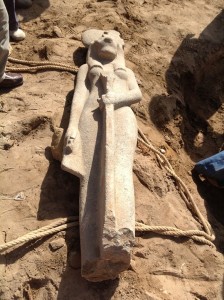 Though modern Egyptian culture may portray the Arabic for “lioness” as an offensive word often hurled at women, our predecessors believed it to be the symbol of the Pharaonic goddess Sekhmet, whom they depicted as a fierce huntress.
Though modern Egyptian culture may portray the Arabic for “lioness” as an offensive word often hurled at women, our predecessors believed it to be the symbol of the Pharaonic goddess Sekhmet, whom they depicted as a fierce huntress.
Sekhmet is the ancient Egyptian warrior goddess who was believed to be a protector of Egyptians. Images of Sekhmet populate everything from film, literature and music to video games. One of the more popular Egyptian deities, she is sometimes referred to as the daughter of Ra, the sun god.
Her name translates into “the one who is powerful” and she is portrayed as having the head of a lioness and the body of a human. Usually depicted with a lotus flower in her right hand and an ankh in her left, she had a major cult that was deeply influential in the culture of ancient Egyptians.
Sekhmet has been worshipped as early as the Old Kingdom and she has been closely associated with Mut, the wife of Amun and sometimes represented as being a more aggressive version of her.
A statue of the goddess has been uncovered in Mut’s temple, just south of the more famous Karnak temple in Luxor. The statue is almost fully intact, depicting Sekhmet with a lioness head and a female body and prominently displays the lotus flower and the ankh. Though the original state of the statue may have been more elaborate, it still stands as a fine example of Pharaonic art and an exquisite example of Sekhmet’s dominance in Egyptian culture.
The statue has been found to be part of the Late Kingdom, specifically from the reign of Amenhotep III. According to the British Museum, King Amenhotep III revered Sekhmet and had a large quantity of her statues erected in his mortuary temple in Western Thebes.
The statue is 180cm long and features a sun disk on the head of Sekhmet as well as a cobra. The statue may have originated somewhere else, particularly where Sekhmet’s cult was historically strong.
Made of granite, the statue was discovered last Tuesday as part of the delegation of the American Research Centre In Egypt (ARCE) with the cooperation of the Ministry of Antiquities, while installing new tiles for the temple’s second hall.
The Minister of the State for Antiquities Affairs, Mohamed Ibrahim, who also announced the discovery, had been present shortly before, as part of ongoing renovations in the Mut temple. The temple is being prepped for its grand opening, where it will be accessible to the public for the first time.
Mut’s temple features many statues of Sekhmet but the Minister was quick to point out that this was the first statue of Sekhmet to be in an upright position.
The statue will be removed for proper storage before it can be shown to the public. Luxor is widely considered to be a capital of Pharaonic culture due to the abundance of ancient Egyptian antiquities, with a popular Egyptian expression affectionately saying it has “two thirds of the world’s antiquities” in Arabic.




